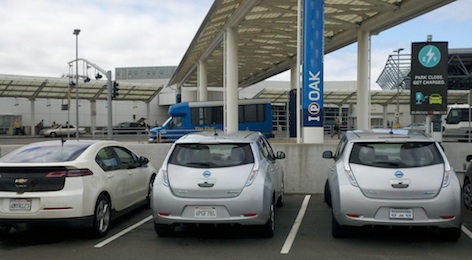California already has over 10,000 of the new electric vehicles on the road and 2,000 public charge points. Over 10,000 new electric charge points will be added to give EV drivers added range. The charge stations will be built by NRG with private money, not public funds.
This will be the world’s largest electric car charging network and include smart grid technological advancements to level grid load, and energy storage and vehicle-to-grid (V2G).
California needs electric cars. Compared to nations, only two countries use more petroleum than California – the United States and China. The Los Angeles Basin and Central Valley historically had such severe health problems that Governor Ronald Reagan established the California Air Resources Board, which continues to encourage cleaner cars and fuel-efficiency.
California Public Utilities Commission and NRG Energy
The California Public Utilities Commission and NRG Energy (NYSE: NRG) have entered into an agreement where NRG will build a comprehensive electric vehicle (EV) charging network in California, investing approximately $100 million over the next four years.
This fee-based charging network will consist of at least 200 publicly available fast –charging stations—installed in the San Francisco Bay area, the San Joaquin Valley, the Los Angeles Basin and San Diego County—which can add 50 miles of range in less than 15 minutes of charging.
The DC-Fast Charging will especially be helpful for drivers of pure battery-electric cars like the Nissan LEAF and Mitsubishi I, many which were purchased with DC-Fast Charge Ports. Currently many of these electric car drivers are limited to ranges of 60 to 120 miles without access to fast charging.
Additionally, NRG’s EV infrastructure commitment will include the wiring for at least 10,000 individual charging stations located at homes, offices, multifamily communities, schools and hospitals located across the State. The charging locations will be easy for drivers to find with Google Maps, smartphone apps, and electric car navigation systems.
NRG California EV Charging includes Smart Grid and V2G
- A minimum of 200 direct current (DC) fast chargers to the state.
- A minimum of 10,000 parking spaces retrofitted with wiring necessary to charge EVs at multifamily buildings, large worksites and civic sites such as universities and hospitals.
- Training and jobs for the installation and maintenance of these charging stations in
- California.
- Smart grid and grid storage services that increase the speed and power of DC fast charging, store electricity to minimize peak-period demand, and enable EV drivers to support electrical grid reliability with needed energy services through vehicle to grid (V2G).
- Significant additional investment in California’s clean technology economy and hundreds of jobs in construction and EV infrastructure manufacturing, maintenance and management.
- Approximately $100 million in infrastructure investment over four years, and $20 million in cash to go to the California Public Utility Commission.
Dynegy and Enron were famously accused of manipulating California’s energy markets leading to a crisis 12 years ago. The agreement, pending approvals and finalization, resolves outstanding litigation arising out of a long-term electricity contract entered into over a decade ago by a subsidiary of Dynegy, then a co-owner with NRG of the portfolio of power generating plants currently owned by NRG in California. NRG assumed full responsibility for resolving this matter in 2006 when NRG acquired Dynegy’s 50% interest in the assets.
“California already leads the way in the development of an alternative energy transportation sector and, with the price of gasoline above $4 per gallon and rising, all Americans need to be giving serious consideration to the increasingly attractive electric vehicle alternative to what former President Bush called ‘our national addiction to foreign oil’,” stated NRG CEO Crane. “This network will be built with private funds on a sustainable business model that will allow NRG to maintain and grow the network as EV adoption grows.”
NRG has been making major investments in utility-scale solar and wind. AeroVironment has been one of its charge station suppliers in Texas.
Over 7 Million Charge Points by 2017
California is often the first point of sale for new electric cars, which are then offered in other states, then all 50 states. Other states gaining momentum in electric car sales and public charge points include Oregon, Washington, Florida, Michigan, and Texas where NRG is also developing a charge point network for subscribers.
Clean Fleet Report forecasts 60,000 to 100,000 electric car sales and leases in the United States in 2012 and 200,000 in 2013. Pike Research forecasts 7.7 million charge points installed globally by 2017.


Having a 15 minute fast charge to go another 50 miles is huge in the electric car market. Eventually the quick battery swap stations will gain traction and make the commute without range anxiety a normal thing. Japan already has quick battery swapping stations for their all electric taxi fleet. I believe the projected cost is somewhere in the $1 per gallon equivalent or $15-$20 per swap. Game changer.